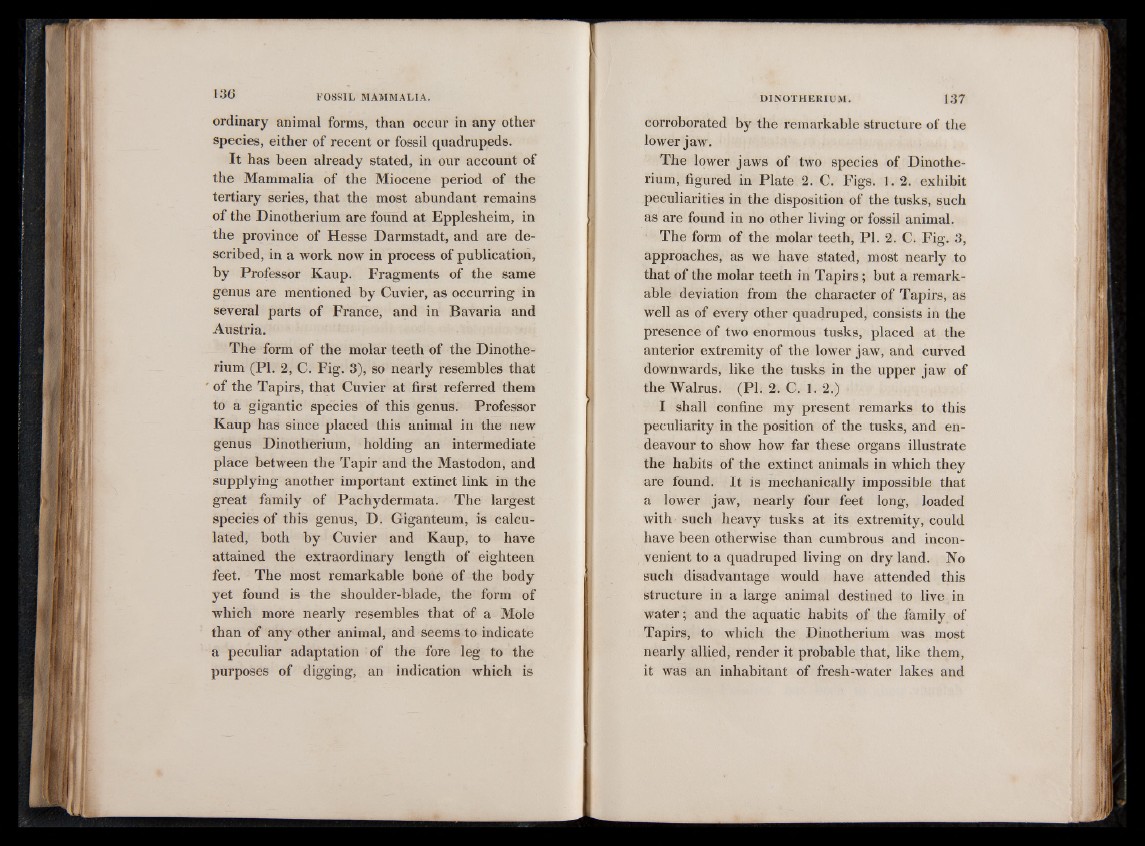
ordinary animal forms, than occur in any other
species, either of recent or fossil quadrupeds.
It has been already stated, in our account of
the Mammalia of the Miocene period of the
tertiary series, that the most abundant remains
of the Dinotherium are found at Epplesheim, in
the province of Hesse Darmstadt, and are described,
in a work now in process of publication,
by Professor Kaup. Fragments of the same
genus are mentioned by Cuvier, as occurring in
several parts of France, and in Bavaria and
Austria.
The form of the molar teeth of the Dinotherium
(PI. 2 , C. Fig. 3), so nearly resembles that
of the Tapirs, that Cuvier at first referred them
to a gigantic species of this genus. Professor
Kaup has since placed this animal in the new
genus Dinotherium, holding an intermediate
place between the Tapir and the Mastodon, and
supplying another important extinct link in the
great family of Pachydermata. The largest
species of this genus, D. Giganteum, is calculated,
both by Cuvier and Kaup, to have
attained the extraordinary length of eighteen
feet. The most remarkable bone of the body
yet found is the shoulder-blade, the form of
which more nearly resembles that of a Mole
than of any other animal, and seems to indicate
a peculiar adaptation of the fore leg to the
purposes of digging, an indication which is
corroborated by the remarkable structure of the
lower jaw.
The lower jaws of two species of Dinotherium,
figured in Plate 2 . C. Figs. 1 . 2 . exhibit
peculiarities in the disposition of the tusks, such
as are found in no other living or fossil animal.
The form of the molar teeth, PI. 2 . C. Fig. 3 ,
approaches, as we have stated, most nearly to
that of the molar teeth in Tapirs; but a remarkable
deviation from the character of Tapirs, as
well as of every other quadruped, consists in the
presence of two enormous tusks, placed at the
anterior extremity of the lower jaw, and curved
downwards, like the tusks in the upper jaw of
the Walrus. (PI. 2 . C. 1 . 2 .)
I shall confine my present remarks to this
peculiarity in the position of the tusks, and endeavour
to show how far these organs illustrate
the habits of the extinct animals in which they
are found. It is mechanically impossible that
a lower jaw, nearly four feet long, loaded
with such heavy tusks at its extremity, could
have been otherwise than cumbrous and inconvenient
to a quadruped living on dry land. No
such disadvantage would have attended this
structure in a large animal destined to live in
water; and the aquatic habits of the family of
Tapirs, to which the Dinotherium was most
nearly allied, render it probable that, like them,
it was an inhabitant of fresh-water lakes and